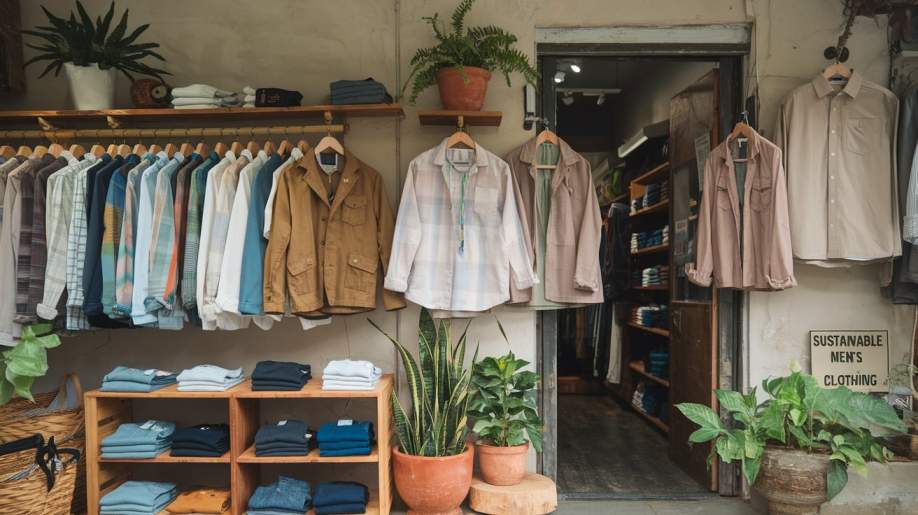Look Good, Feel Good: Embrace Sustainable Fashion Choices
As fashion increasingly plays a role in environmental harm, embracing sustainable shopping for men’s apparel has never been more crucial. This method minimizes waste and pollution while also promoting fair labor practices. By grasping the concepts of sustainable fashion and choosing wisely, men can create a wardrobe that showcases their style while reducing their environmental impact. This guide will explore how to assess your current clothing, choose sustainable brands, shop mindfully, and care for your garments, ultimately promoting a more responsible and conscious approach to fashion. Together, we can bring about a positive change for our planet.
Understanding Sustainable Fashion
- Definition: Sustainable fashion refers to clothing and accessories produced in environmentally friendly ways and designed to last. It requires an all-encompassing strategy that takes into account the entire lifecycle of a product, beginning with raw materials and continuing through to disposal.
- Key Principles: Sustainable fashion is founded on key principles such as ethical manufacturing, reducing waste, sourcing materials responsibly, and ensuring fair labor practices. Brands committed to sustainability prioritize these values throughout their supply chains.
- Environmental Impact of Fast Fashion: The fast fashion sector is marked by quick production timelines and inexpensive clothing, resulting in significant waste, environmental damage, and resource exploitation. This model encourages a throwaway culture, significantly impacting the environment.
- The Role of Consumers: Consumers play a crucial role in promoting sustainable fashion. By making informed purchasing decisions and supporting ethical brands, individuals can drive demand for sustainable practices.
- Benefits of Sustainable Fashion: Embracing sustainable fashion helps reduce carbon emissions, conserves water, and minimizes pollution. It also promotes a more just economy by guaranteeing fair pay and safe working environments for garment workers.
- Future of Fashion: As awareness grows, the fashion industry is gradually shifting towards sustainability, with innovations in materials and production techniques paving the way for a more responsible future.
Tips for Sustainable Shopping
- Assess Your Wardrobe: Start by evaluating what you already own. Identify pieces that you wear frequently and those that you rarely use. This will assist you in steering clear of impulse buys and promote thoughtful shopping.
- Set a Budget: Determine a budget for sustainable shopping that allows you to invest in quality items rather than quantity. This approach encourages you to choose versatile, timeless pieces that will last longer.
- Research Brands: Look for brands that prioritize sustainability in their practices. Investigate their sourcing, manufacturing processes, and labor policies. Websites like Good On You offer ratings and reviews of various brands’ ethical practices.
- Choose Quality Over Quantity: Invest in well-made garments designed to last. Using high-quality materials and skilled craftsmanship can minimize the frequency of replacements, leading to long-term savings.
- Shop Secondhand: Thrift stores, consignment shops, and online platforms like Poshmark and Depop offer a treasure trove of secondhand clothing. This not only saves money but also extends the life of garments already in circulation.
- Prioritize Sustainable Materials: Look for clothing made from organic, recycled, or upcycled materials. Fabrics like organic cotton, Tencel, and hemp are environmentally friendly alternatives to conventional textiles.
- Consider Renting: For special occasions, consider renting clothing instead of purchasing new items. Rental services provide access to high-quality pieces without the environmental impact of ownership.
- Practice Mindful Buying: Before buying something, consider whether you genuinely need it and if it reflects your personal style and values. This reflection can help reduce impulse buys and promote thoughtful consumption.
Maintaining Your Clothing Sustainably
- Proper Washing Techniques: Wash clothes in cold water and use gentle detergents to minimize energy consumption and reduce wear and tear. Always follow care labels for specific instructions.
- Air Drying: Whenever possible, opt for air drying your clothes instead of using a dryer. This not only saves energy but also helps maintain the fabric’s integrity and shape.
- Iron with Care: If ironing is necessary, use the appropriate temperature settings and consider using a steamer to reduce wrinkles. This prevents damage to the fabric and extends the garment’s life.
- Repair Rather Than Replace: Invest time in learning simple repairs, like sewing buttons or mending small tears. This prolongs the lifespan of your clothing and minimizes waste.
- Store Properly: Store garments in a cool, dry place, using breathable garment bags to protect them from dust and pests. Avoid hanging delicate fabrics that can stretch out of shape.
- Rotate Your Wardrobe: Regularly rotate your clothes to avoid excessive wear on your favorite pieces. This practice promotes variety and ensures all items are used equally.
Final Thoughts
Sustainable shopping for men’s clothing is not just a trend; it’s a necessary shift towards responsible fashion that benefits both the planet and society. By grasping sustainable practices, making thoughtful decisions, and taking care of our clothing, we can together minimize the harmful effects of the fashion industry. Embracing quality over quantity, supporting ethical brands, and opting for secondhand or rental options are effective ways to cultivate a sustainable wardrobe. Ultimately, each conscious decision contributes to a healthier environment and promotes a culture of sustainability that encourages future generations to value responsible fashion choices.


